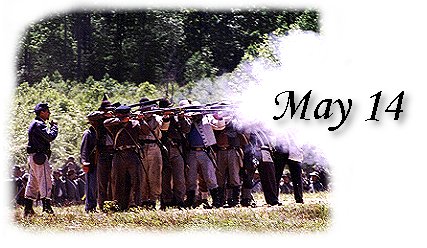
![]()
On the morning of May 14 about 150,000 troops representing elements of four armies (three Federal, one Confederate) were situated in and near Resaca, Georgia ready for battle. The two sides formed an upside-down "L" that's left rested on the Oostanaula River with the right on the Conasauga River. Johnston's position was highly concentrated, which would allow him to direct massive firepower upon expected Union assaults at any point. The Southerners had had time to heavily fortify much of their line, especially in front of the village proper. Further to the north, Hood's Corps had gotten into position later than most of the rest of the Army of Tennessee and was not as well entrenched.
Sherman, on the other hand, had prepared his own line. Most of his troops were ready for an assault. They had spent much of the evening of May 13 and early morning of May 14 placing their lines in good order over the difficult terrain of rolling hills, heavy woods, and thick undergrowth. No easy task to be sure. His plentiful artillery was beginning to take up key positions on the high ground he had captured on May 13.
Though beginning at 6 a.m. there was heavy skirmishing similar to what was experienced around Dalton the week before, it was 1 p.m. before the first of two attacks Sherman made that day got under way. It involved the smallest of his three armies, Schofield's Army of the Ohio which consisted of two divisions, one commanded by the capable Brigadier General Jacob D. Cox, the other by Brigadier General Henry M. Judah. Major General John M. Palmer was also ordered to support the right flank of the assault with his XIV Corps from Thomas' army.
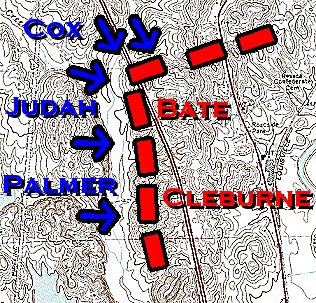 |
| This shows the attack by Federal troops upon the Confederate positions along Camp Creek, May 14, 1864. Judah and Cox fail to coordinate their efforts while Palmer's Corps offers support. The two lines running parallel down the map are Interstate 75 today. The single line further east is US Highway 41 just north of Resaca. North is up. |
The attack was made over two very different types of terrain. Cox's front would strike around the point where Hindman's division joined Hood's Corps with Hardee's Corps at an angle precisely where the upside-down "L" in the Confederate line shifted back toward the east. Here the ground was covered heavily in brush and trees and was rolling with small hills. Judah's and Palmer's men, however, were confronted with fewer such natural obstacles until they got to an open field through the middle of which ran Camp Creek. Beyond the creek Hardee's Corps was entrenched upon a wooded ridge.
Due to the nature of the terrain and to some confusion in command, the Federals hit the Southern line in a disjointed fashion, with Judah storming ahead of Palmer's and Cox's troops. This was the beginning of a bloody repulse for the Northern troops. The action is described by Brigadier General Nathaniel C. McLean, commander of Judah's first brigade:
"I accordingly ordered an advance, and as well as I was able kept my men in line in passing over the troops of the Fourteenth Corps and through the dense and tangled undergrowth of the forest. We passed over one or two ridges and valleys, and at length reached a ridge, the top of which was within musket-range of the earth-works which crowned the hill fortified by the enemy. They here opened fire upon us, but my men steadily advanced, passing over a fence at the foot of the hill, when they came upon a plain exposed to the full fire of the enemy from artillery and musketry. As soon as the cleared ground was reached the whole line started forward with a tremendous shout for the rebel works. Never did men more gallantly breast the storm of death which was hurled upon them from every quarter, and their advance continued until they were broken by a bog and creek into which they plunged more than waist deep. To climb the opposite bank under such a murderous fire was more than they could do, especially when we found the works so strong that with the force then attacking there was not the slightest chance of success. Under these circumstances we were forced back, leaving fully one-third of the attacking party killed and wounded on the field. A large number of the men found protection under the banks of the creek, and from there kept up a constant fire upon the men who worked the artillery in the rebel works, and succeeded in compelling them to load their guns lying down." (O.R. No. 311)
Palmer's Corps tried to offer some assistance on Judah's right, but the story was much the same. Brigadier General Richard W. Johnson's report tells of the action on that portion of the battlefield:
"I found the enemy strongly posted and fortified on the hither slope and near the crest of a long, elevated ridge, their right slightly refused from the direction of my line. In front of their position was an open field of some 400 yards wide, sloping gradually down to a creek directly in my front. The general course of this creek in front of my line was nearly parallel to the enemy's works; the bottom was in some places miry with a considerable depth of water-in others quite the reverse, its crooked channel filled in some places with a dense underbrush in others obstructed by fallen trees and drift. If afforded a serious obstacle to the advance of troops in line, as the result proved, as the land rose immediately from the creek in an abrupt bluff of nearly the same height as the enemy's position beyond, and then gradually sloped down again to the westward. With my skirmishers posted along the creek, I reformed my lines in the woods behind the slope, to the rear of it, and awaited instructions. At about 11 a. m. I received notice front the major-general commanding corps that as soon as the left should get into position an assault would be made along the whole line. I was ordered to advance as soon as by the firing I should be warned of the movement of the troops on my immediate left. Accordingly, about 11.30, heavy firing on the lines of Baird's division indicating that his troops were advancing, my two brigades in the line moved forward, Scribner's having already, in anticipation of the movement, been brought up into close supporting distance. General Carlin, who lay very near the creek mentioned, threw forward his skirmishers, driving those of the enemy within their works, and moved forward his lines across the creek. No sooner had his first line emerged from the cover of the woods than the enemy--infantry and artillery--opened upon it with terrible effect. Notwithstanding this, however, Carlin pushed forward both lines beyond the creek and nearly half way across the open field. The passage of the creek had, however, sadly disordered his lines, and finding it impossible to reform them while advancing so rapidly as the emergency of occasion required, hopeless, moreover, of holding his position even if the assault should succeed, Carlin fell back to the cover of the creek, the eastern bank of which offered in some places all the protection of a well-constructed fortification. Here he remained, by my direction, all day, keeping up a desultory but effective fire in reply to the enemy's. King's brigade, which lay considerably farther from the creek than Carlin's, did not advance so far, and, when it was seen that Carlin had suffered a repulse, halted. Two 12-pounder guns of the enemy's in my front had opened upon our advance, and continued their fire subsequently, at intervals, with damaging effect. As soon as a practicable road could be found I brought forward two pieces of Captain Dilger's battery, I, First Ohio Light Artillery, and caused them to be placed in position on the crest of the bluff overlooking the creek and near my center. The admirable practice of this section, conducted under the supervision of Captain Dilger in person, soon closed out the enemy's pieces, and was quite as annoying to them as theirs had been before to us. More than once their infantry, driven from their works by Dilger's shell, were shot down by my sharpshooters before they could gain the cover of the works in their rear." (O.R. No. 90) Note: This report often refers to the brigade of Brigadier General William P. Carlin.
Judah's and Palmer's attack was repulsed by the troops of Major General William B. Bate's and Pat Cleburne's divisions. Cleburne's men responded to the assault with their accustomed efficiency. Captain Irving A. Buck, Cleburne's Assistant Adjutant General described the events of May 14 as follows: "Early on the morning of the 14th Cleburne, on foot reconnoitered the ground in his front, going across the valley to the edge of the stream (Camp Creek), a hazardous and imprudent thing, as the hill beyond the stream was heavily wooded, and soon afterwards occupied by the enemy, who immediately opened upon Cleburne's command a heavy fire. In the afternoon they made several attempts to charge across the open level ground, but uniformly without success, notwithstanding one of their commanders was heard to appeal to his men and incite them by saying, 'You are the men who scaled Missionary Ridge, and you can carry this!' But all to no effect, for they were then confronting the men who repelled every assault upon the part of the line held by them in battle. His men would advance a short distance into the open and quickly recoiled under the fire of Cleburne's veterans." (Buck, p.211)
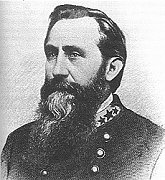 |
|
Major
General William B. Bate
|
It was more difficult for Bate's men, especially on the portion of the line held by the famous "Orphan Brigade." This veteran unit was so named because it was composed of Confederate regiments raised in Kentucky early in the war. Since Union forces controlled their state for practically the entire war the troops felt themselves "orphaned." These men served as the "point" of the angle of the Confederate line as it shifted from along Camp Creek back to the east. This meant that this brigade was not only faced with Judah's assault, but that of Cox's division as well. After repulsing Judah, the fighting intensified against Cox. A history of the brigade tells the story: "The Federals attacked repeatedly. 'Column after column came down in full view, and moved right toward us,' wrote an Orphan. Some of the enemy got within seventy-five yards of their line before (the brigade) opened up. 'It was harvest time with the Orphan Brigade,' said one, 'and every available contrivance was used for reaping the field before us. The fighting became so intense that when John Gordon of Company D, 4th Kentucky, fell dead, his comrades spent the rest of the day stepping over him in the melee. Only with nightfall could someone find time to take him from his place in the line. The new corps of sharpshooters operated…somewhat in advance. 'Their terrible rifles soon attracted the fury of the Federal artillerymen,' wrote an Orphan of the 4th. Before the day was out, half of the elite marksmen lay dead or wounded. Yet others, in the midst of this terrible holocaust, found time to admire pityingly a little kitten caught between the battle lines and crying in its terror. Finally, (a gunner) jumped the earthworks and ran forward to grasp the cat and return it safely. Thereafter the tortoise tabby was a familiar sight perched on his friend the gunner's shoulder or astride a caisson. In honor of the occasion the Orphans named it 'Resaca'." (Davis, 217-218)
Cox's division, supported by two divisions of Howard's IV Corps (just arriving from Dalton), assailed Bate's and Hindman. Their attacked was delayed due to the nature of the terrain on that portion of the battlefield and to the fact that Howard's Corps was late in getting ready for battle. By the time this portion of the Union assault got moving, Judah and Palmer were already repulsed at Camp Creek. This allowed the Confederates to concentrate their fire, in spite of the Federal's terrific artillery barrage, against Cox as is evidenced in Cox's official report:
"The skirmish line of the division already occupied the edge of the wooded land across the open valley, some 200 yards wide, immediately in our front, when the command to advance was given and the whole division moved steadily forward, the enemy opening immediately with artillery from batteries in position down the valley on our right, and which had an oblique fire upon our lines as we passed through the low ground. After crossing the open we passed over several wooded ridges in succession, and through a deep though narrow channel of the creek, which, with its perpendicular sides, skirted by a tangled thicket, became a serious obstacle to the advancing troops. The lines were quickly reformed after passing the brook and again moved forward, steadily driving the enemy's skirmishers backward toward their works. These skirmishers were so strongly re-enforced that they were only to be driven back by the main line of our troops, who advanced, making an occasional momentary halt to deliver their fire. A short halt was made, bayonets were fixed, and the whole command charged the hill and carried the line of rifle-pits on the crest, driving the enemy back upon a second line some 250 yards from the first on our left, but approaching much nearer on our right. The first line of the Second Brigade was first in entering the works, but these were almost instantly entered by the First Brigade also farther to the left. The enemy immediately opened with both artillery and musketry from their second line, which extended far beyond both flanks of the division, and no troops being as yet in position on either our right or left, the division was halted, the Second Brigade (Manson's) occupying the enemy's works with their first line, and the First Brigade (Reilly's) occupying them with the second line, advancing the first line to the protection of a small intervening ridge between them and the new line occupied by the rebels, from which they were able to silence with their rifles a battery which was playing destructively upon the Second Brigade. No artillery had been able to accompany the division in its advance to attack, the broken nature of the ground and the physical obstacles of the creeks and thickets entirely preventing. The continuous heavy fire of the enemy caused, however, a considerable loss in both the One hundred and third Ohio and Fifth Tennessee while advancing to their position. An hour later I reported the ammunition of the whole division us being almost exhausted, and it being impossible to get wagons forward to the lines held by the command, I was notified that we would be relieved by the Fourth Corps and withdrawn temporarily to enable us to replenish the cartridge-boxes. A little after 3 p. m. General Harker's brigade, of Stanley's division, Fourth Corps, advanced under a galling fire of all arms to relieve the Second Brigade, and while preparing to effect the change Brigadier-General Manson was severely injured by concussion of a shell exploding near him, and was carried off the field." (OR No. 351)
Cox officially reported his losses in the attack as 562 killed, wounded, and captured. Judah's division lost over 700 men. So, the Union forces sustained more than 1,300 casualties (counting those of Palmer's and Howard's supporting corps) in about two hours of fighting. With this repulse, Johnston began to turn his thoughts toward possibly taking the offensive himself with the idea of cutting Sherman's entire force off from Snake Creek Gap and capturing a large portion of the Union armies. (Castel, p. 163) Johnston spent most of the morning with Hood and realized from scout reports that Howard's Corps did not extend as far to the east as did the Confederate lines. Therefore, it was possible to execute a turning movement against the Union left flank.
 |
|
Major
General David S. Stanley. His division was struck in the flank by
the Confederate attack and driven from its positions
|
Johnston ordered Hood's Corps into action. At 5 p.m. the divisions of Major General Carter L. Stevenson and Major General Alexander P. Stewart, having not encountered any opposition along their respective fronts, advance with the idea of getting behind Howard's Corps. According to Dr. Philip Secrist: "Although the Confederate divisions began the advance almost simultaneously, Stewart's men, having the greater distance to cover, did not succeed in making contact with the enemy. Disorganized by rough terrain and some long-range artillery fire, Stewart halted his division after fifteen or twenty minutes to reorganize his straggling lines… Meanwhile, Stevenson's two brigades, having the shorter distance to cover, made contact with Sherman's exposed flank almost immediately. The attack struck Stanley's right brigade first and broke it. In wild disorder, a race between men in blue and gray began. The flight took Stanley's regiments through a depression where pines served as cover and screen. …the fleeing regiments passed to the left of Captain Peter Simonson's 5th Indiana Battery which was in position atop the hill. A frantic effort was made here to rally the panic-stricken regiments to protect the Federal battery." (Secrist p. 33 - 35)
Captain Simonson's official report describes what happened at this decisive moment: "I ordered the Fifth Indiana to open fire on the enemy, who were advancing in heavy force out of a thick woods, about 800 yards in front, which did not immediately check them as they advanced up the fields, driving our infantry back to and part of it in the rear of the battery, thus leaving the field clear in front and the enemy only about 400 yards distant. A very rapid fire of canister was opened on the advancing foe, which quickly cleared the field, the greater portion of the enemy's troops going into the woods toward our left. The pieces were immediately turned by hand to the left, and spherical case and shell were used, canister being held in readiness in case they gained the hill on our immediate left. They soon appeared on this hill and opened with a heavy volley of musketry, shooting at least twenty feet above the battery. The regiments which were upon the right and left of the battery seeing themselves flanked by a heavy force, immediately withdrew. The distance to the top of the hill was 150 yards. The men themselves, without particular orders, double-shotted the pieces with canister, and maintained the most rapid firing possible. Some few of the rebels reached the road at the foot of the hill, within fifty yards of the battery, but the main body appeared to be greatly disconcerted by the firing, and although their officers could be seen and heard trying to urge them forward, they very quickly put the hill between themselves and the pieces. They made one more endeavor to get over the hill more to our left, but were met in this attack at first by the fire of the battery with canister, and as they turned, by a volley from Robinson's brigade, of Williams' division, of General Hooker's corps, and who immediately charged and drove them clear over the hill out of sight in great confusion." (OR No. 79)
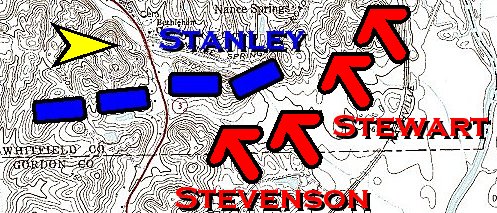 |
| This map depicts the Confederate attack on the exposed Union right flank on May 14, 1864. Stevenson's division drives Stanley's division while Stewart fails to encounter significant opposition. The yellow arrow indicates the approximate location of the 5th Indiana Battery which, along with reinforcements from Hooker's XX Corps, helped stop the Southern advance. The dark curved line is US Highway 41 as it crosses the modern Gordon and Whitfield County lines. North is up. |
The 5th Indiana Battery delayed the Confederate advance, but it would most likely have fallen (and with it a key position on the battlefield) had advanced elements of Major General Joseph Hooker's XX Corps not arrived upon that portion of the field in timely fashion. Sherman had ordered Hooker out of his position south of Palmer's Corps earlier in the day when he realized (as did Johnston) his left flank was exposed to a potential counterattack. While the battle along Camp Creek was raging, Hooker moved well over a mile through the same difficult terrain through which everyone else was attempting to maneuver. His arrival at the exact moment when the Confederates were about to turn Sherman's entire position was a critical moment in the battle.
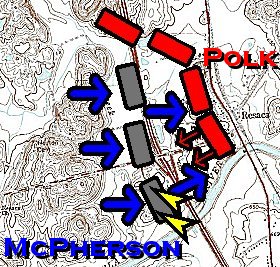 |
| McPherson's successful attack upon Polk's Corps late on May 14, 1864. The gray markers indicate the initial Confederate position, the red is the final one. The two yellow arrows point to critical hills that were taken in the assault, allowing Union artillery to bombard the Resaca bridge. The small red arrows indicate where Polk attempted to retake those hills. This map shows in intersection of Georgia Highway 136 and Interstate 75 today (Exit 320). The entire town of Resaca can be seen with US Highway 41 dissecting it. The Oostanaula River is at the bottom of the map. North is up. |
Perhaps the most significant development of the day came not from Camp Creek nor the Union left flank but along the front before Resaca proper. Polk's Corps had been skirmishing with McPherson's all day there. At 5:30 p.m. McPherson was ordered to launch a full-scale attack on Polk. This was done to prevent Polk from sending any troops northward to aid in Hood's attack or perhaps to exploit any thinning of the Southern line if the Army of Tennessee had already sent men north. A great deal more was accomplished, however, as summarized by Bill Scaife: "…Charles R. Woods' 1st Brigade pushed across the creek, the 26th Iowa Regiment in advance and the 12th Missouri Regiment protecting the flank. Woods was supported on the right by Giles A. Smith's 1st Brigade of Morgan L. Smith's 2nd Division - the with 57th Ohio, under the command of Colonel Americus V. Rice, leading the skirmishers. Encouraged by thousands of 'hurrahs' from Logan's XV Corps on the hills to their rear, Woods' and Smith's men ascended the slope and established a lodgement before dark. By daylight on May 15, Logan's troops had secured the position, while Polk reformed his Confederate line through the cemetery just west of the railroad, in the very outskirts of Resaca. Since Federal artillery could then command the railroad bridge across over the Oostanaula River, Johnston ordered a new pontoon bridge erected a mile upriver, hopefully out of range of the guns." (Scaife p. 30) He also ordered Polk to retake the hills. Three spirited Confederate assaults upon the positions, however, came to nothing. Polk's men retreated and strengthened their lines during the night.
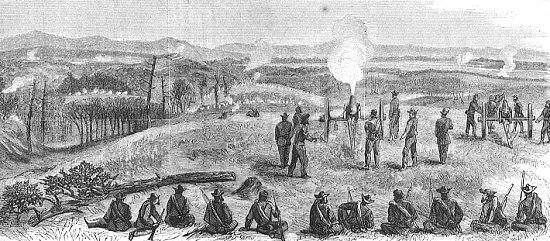
Shelling the Railroad near Resaca from Harper's Weekly.
May 14 ended inconclusively. The main Federal assault of the day was badly mismanaged and soundly repulsed. Ultimately, Judah would be dismissed from command for his part in the debacle. Polk's men have been driven from key positions overlooking Resaca, threatening Johnston's ability to retreat. Meanwhile, on the northern part of the battlefield, Johnston and Hood were encouraged by the destruction wrought upon the exposed Northern left flank. Despite being unable to accomplish all that was hoped for, that evening Johnston ordered the attack be resumed the next day. Soon news would reach him that would cause him to temporarily countermand that order. (See Lay's Ferry for details.)



